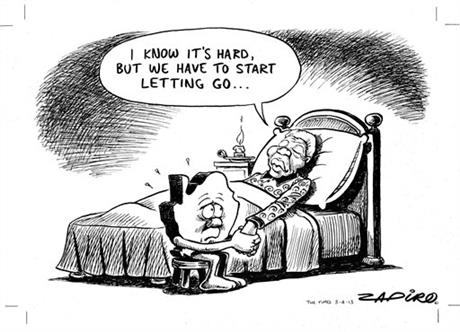
By CHRISTOPHER TORCHIA
This photo released by Jonathan Shapiro, shows a cartoon depicting former South African President Nelson Mandela, dated Monday, March 4, 2013. Shapiro, who signs “Zapiro” on his cartoons, said his newspaper editors grew edgy earlier this year when he submitted an image of an ailing Mandela in bed, holding hands with a forlorn nation – symbolized by a map of South Africa with a frowning face. It captured the angst of South Africans who revere the former president and peacemaker, and worry about a future without him, even though the 95-year-old is long retired and has been critically ill for months. (AP Photo)
South Africa Cartoonist
FILE – In this Tuesday, Dec. 14, 2010 file photo, cartoonist Jonathan Shapiro, who signs his work as ‘Zapiro’, poses for a photo with a local newspaper at his office in Cape Town, South Africa. Shapiro, who signs “Zapiro” on his cartoons, said his newspaper editors grew edgy earlier this year when he submitted an image of an ailing Mandela in bed, holding hands with a forlorn nation – symbolized by a map of South Africa with a frowning face. It captured the angst of South Africans who revere the former president and peacemaker, and worry about a future without him, even though the 95-year-old is long retired and has been critically ill for months. (AP Photo/Schalk van Zuydam, File)
Prev
1 of 2
Next
JOHANNESBURG (AP) — Zapiro, an award-winning South African cartoonist, likes to stir things up, and he did that by putting words in Nelson Mandela’s mouth.
Jonathan Shapiro, who signs “Zapiro” on his cartoons, said his newspaper editors grew edgy earlier this year when he submitted an image of an ailing Mandela in bed, holding hands with a forlorn nation — symbolized by a map of South Africa with a frowning face. It captured the angst of South Africans who revere the former president and peacemaker, and worry about a future without him, even though the 95-year-old is long retired and has been critically ill for months.
“I know it’s hard, but we have to start letting go … ” Mandela tells the nation in the cartoon.
Shapiro, 55, has made a career of stripping away taboos and artifice with satire. Sometimes he gets sued, most notably by President Jacob Zuma. The Mandela cartoon in April for The Times, a South African newspaper, was one of his gentler efforts and a commentary on a nation that showed promise on Mandela’s watch after the end of white rule in 1994 but grapples today with economic inequality, corruption and other ills.
“I think people are saying, ‘We have to move on from where we are at the moment because we’re not in a good place,'” Shapiro said last week at the annual dinner of the Foreign Correspondents’ Association.
Shapiro, who has worked for a variety of South African newspapers in the past two decades, pokes relentlessly at politicians, athletes, celebrities and institutions.
“When I get into those dark spaces and I think about some of the things that are happening, I’m afraid I just let rip,” he said in a summation of his work this year.
One of those spaces involved a Mozambican taxi driver who died after he was dragged from a South African police vehicle in February, depicted by Shapiro in a Sunday Times cartoon. “SA’s reputation,” reads a caption on the victim’s shirt.
South Africa often engages in a push-and-pull over its international image. Shapiro’s cartoon captured just how bad things sometimes look to the outside world. In contrast, Brand South Africa, a state-funded agency, seeks to build national pride and attract investment.
Shapiro has recently been criticized for a cartoon depicting the Hindu deity Ganesha as a wealthy symbol of Indian cricket, whose team embarks on a shortened tour of South Africa next month amid a row with South African cricket officials.
“This is a metaphor and it’s so obviously not an attack on Hinduism,” said Shapiro, who has not been sued for the image.
Commentator Kalim Rajab wrote on the Daily Maverick website that Shapiro’s choice of deity was unfortunate and that he expected Hindus to express their concern. But he described the cartoon as a legitimate social comment.
“Artists (and particularly satirists, which Zapiro is) are there to provoke, to push the boundaries, to ask the uncomfortable questions — because this is ultimately how we move forward as a society,” Rajab wrote.
In 2008, two years after Jacob Zuma was acquitted of rape charges, Shapiro depicted him with his pants unzipped, preparing to rape a blindfolded, female figure of Lady Justice. Shapiro was commenting at the time on allegations Zuma was trying to intimidate legal authorities. Zuma became South Africa’s president in 2009 and later sued the cartoonist for alleged defamation, but dropped the case last year. In doing so, Zuma said freedom of expression must be balanced with the right to dignity and privacy.
Legal problems are not new to Shapiro, who was arrested and detained when his cartoons took on South Africa’s apartheid regime.
“I may seem flippant,” Shapiro said. “But underneath, I’m a fighter.”



